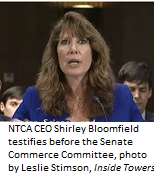
“We need to explore new ways to reduce the cost of broadband deployment,” (which would include towers and antennas), said Thune, referring to his Mobile Now Act which he and Ranking Member Sen. Bill Nelson (D-FL) recently introduced.
It would make broadband deployment more affordable by streamlining the red tape broadband providers face and by helping to make more wireless spectrum available for mobile broadband services.
Rather than reinventing the wheel, NTCA–The Rural Broadband Association CEO Shirley Bloomfield suggested regulators look at what’s working and what isn’t in terms of how carriers are incentivized to provide broadband in rural areas. “In many parts of rural America, the challenges of distance and density are so great that they cannot sustain even one broadband network.”
She highlighted NTCA’s Smart Rural Community program which gets local officials involved to help explain what broadband can do for them in terms of public safety or telemedicine, for example. “It’s a great way to understand that when you enter rural America it’s not a backwater. When you enter, we’ve got highway signs that say ‘You’re entering a Smart Community,’” Bloomfield said.
She praised much of the FCC’s Universal Service Fund programs, but said those are capped at 2010 levels and the funding is insufficient. That affects whether companies like NCTA members can make a business case to deploy rural broadband, which often means they can’t get a bank loan, according to the executive.
As Congress develops an infrastructure package, she recommends lawmakers look at accountability — how dollars dispensed are used. She and others who testified recommended the government give states more leeway in how those dollars are spent as well as reduce red tape. Typical NTCA members spend 85 hours a year filling out paperwork, which is hard to do when you only have 26 employees “and you’re trying to put fiber in the ground,” Bloomfield said.
She stressed that fiber will help make 5G a reality. “Wireless needs wires. You still need that fiber network for 5G and you’re going to have to cross a lot of land to do it.”
March 2, 2017




Reader Interactions